Duration of Hydrothermal Alteration and Mineralization of the Don Manuel Porphyry Copper System, Central Chile
Abstract
1. Introduction
2. Geology of the Don Manuel Porphyry Copper System
2.1. Intrusive Rocks
2.2. Coya Machalí Formation
3. Hydrothermal Alteration and Mineralization
3.1. Early Stage
3.2. Primary Stage
3.3. Late Stage
3.4. Breccias
3.5. Hydrothermal Alteration at Paredones
4. Methods
4.1. Re-Os Geochronology
4.2. 40Ar/39Ar Geochronology
5. Geochronology
5.1. Molybdenite Re-Os Geochronology
5.2. Hydrothermal Biotite 40Ar/39Ar Geochronology
6. Discussion
6.1. Lifespan of the Hydrothermal System
6.2. Comparisons with Other Miocene–Pliocene Deposits in Central Chile
6.3. Uplift and Exhumation of the DMIC and Porphyry Copper System
7. Conclusions
Supplementary Materials
Author Contributions
Funding
Institutional Review Board Statement
Informed Consent Statement
Data Availability Statement
Acknowledgments
Conflicts of Interest
References
- Gilmer, A.K.; Sparks, S.; Rust, A.C.; Tapster, S.; Webb, A.D.; Barfod, D.N. Geology of the Don Manuel igneous complex, central Chile: Implications for igneous processes in porphyry copper systems. GSA Bull. 2017, 129, 920–946. [Google Scholar] [CrossRef]
- Skewes, M.A.; Stern, C.R. Tectonic trigger for the formation of late Miocene Cu-rich breccia pipes in the Andes of central Chile. Geology 1994, 22, 551. [Google Scholar] [CrossRef]
- Kay, S.M.; Godoy, E.; Kurtz, A. Episodic arc migration, crustal thickening, subduction erosion, and magmatism in the south-central Andes. GSA Bull. 2005, 117, 67. [Google Scholar] [CrossRef]
- Marot, M.; Monfret, T.; Gerbault, M.; Nolet, G.; Ranalli, G.; Pardo, M. Flat versus normal subduction zones: A comparison based on 3-D regional traveltime tomography and petrological modelling of central Chile and western Argentina (29°–35°S). Geophys. J. Int. 2014, 199, 1633–1654. [Google Scholar] [CrossRef]
- Farías, M.; Comte, D.; Charrier, R.; Martinod, J.; David, C.; Tassara, A.; Tapia, F.; Fock, A. Crustal-scale structural architecture in central Chile based on seismicity and surface geology: Implications for Andean mountain building. Tectonics 2010, 29, 29. [Google Scholar] [CrossRef]
- Yáñez, G.; Cembrano, J.; Pardo, M.; Ranero, C.; Selles, D. The Challenger–Juan Fernández–Maipo major tectonic transition of the Nazca–Andean subduction system at 33–34 S: Geodynamic evidence and implications. J. S. Am. Earth Sci. 2002, 15, 23–38. [Google Scholar] [CrossRef]
- Stern, C.R. Active Andean volcanism: Its geologic and tectonic setting. Rev. Geol. Chile 2004, 31, 161–206. [Google Scholar] [CrossRef]
- Pardo, M.; Comte, D.; Monfret, T. Seismotectonic and stress distribution in the central Chile subduction zone. J. S. Am. Earth Sci. 2002, 15, 11–22. [Google Scholar] [CrossRef]
- Cannell, J.; Cooke, D.R.; Walshe, J.L.; Stein, H. Geology, Mineralization, Alteration, and Structural Evolution of the El Teniente Porphyry Cu-Mo Deposit. Econ. Geol. 2005, 100, 979–1003. [Google Scholar] [CrossRef]
- Warnaars, F.W.; Holmgren, D.C.; Barassi, F.S. Porphyry copper and tourmaline breccias at Los Bronces-Rio Blanco, Chile. Econ. Geol. 1985, 80, 1544–1565. [Google Scholar] [CrossRef]
- Davidson, P.; Kamenetsky, V.S.; Cooke, D.R.; Frikken, P.; Hollings, P.; Ryan, C.G.; Van Achterbergh, E.; Mernagh, T.; Skarmeta, J.; Serrano, L.; et al. Magmatic Precursors of Hydrothermal Fluids at the Rio Blanco Cu-Mo Deposit, Chile: Links to Silicate Magmas and Metal Transport. Econ. Geol. 2005, 100, 963–978. [Google Scholar] [CrossRef]
- Maksaev, V.; Townley, B.; Palacios, C.; Camus, F. Metallic ore deposits. In The Geology of Chile; Geological Society of London: London, UK, 2018; pp. 179–199. [Google Scholar]
- Candia, W.; Oviedo, O.; Nuñez, E. Don Manuel Project Seasonal Report. In Minera Aurex Reports; Minera Aurex: Santiago, Chile, 2009; p. 52. [Google Scholar]
- Gilmer, A.K.; Sparks, R.S.J.; Blundy, J.D.; Rust, A.; Hauff, F.; Hoernle, K.; Spencer, C.J.; Tapster, S.; Stephen, R.; Sparks, J. Petrogenesis and Assembly of the Don Manuel Igneous Complex, Miocene–Pliocene Porphyry Copper Belt, Central Chile. J. Pet. 2018, 59, 1067–1108. [Google Scholar] [CrossRef]
- Charrier, R.; Wyss, A.; Flynn, J.J.; Swisher, C.C., III; Norell, M.A.; Zapatta, F.; McKenna, M.C.; Novacek, M.J. New evidence for late Mesozoic-early Cenozoic evolution of the Chilean Andes in the upper Tinguiririca valley (35 S), central Chile. J. S. Am. Earth Sci. 1996, 9, 393–422. [Google Scholar] [CrossRef]
- Charrier, R.; Baeza, O.; Elgueta, S.; Flynn, J.; Gans, P.; Kay, S.; Muñoz, N.; Wyss, A.; Zurita, E. Evidence for Cenozoic extensional basin development and tectonic inversion south of the flat-slab segment, southern Central Andes, Chile (33°–36° S.L.). J. S. Am. Earth Sci. 2002, 15, 117–139. [Google Scholar] [CrossRef]
- Godoy, E.; Yañez, G.; Vera, E. Inversion of an Oligocene volcano-tectonic basin and uplifting of its superimposed Miocene magmatic arc in the Chilean Central Andes: First seismic and gravity evidences. Tectonophysics 1999, 306, 217–236. [Google Scholar] [CrossRef]
- Atkinson, W.W., Jr.; Souviron, A.; Vehrs, T.I.; Faunes, A. Geology and Mineral Zoning of the Los Pelambres Porphyry Copper Deposit. Soc. Econ. Geol. Spec. Publ. 1996, 5, 131–156. [Google Scholar]
- Spencer, E.T.; Wilkinson, J.J.; Creaser, R.A.; Seguel, J. The Distribution and Timing of Molybdenite Mineralization at the El Teniente Cu-Mo Porphyry Deposit, Chile. Econ. Geol. 2015, 110, 387–421. [Google Scholar] [CrossRef]
- Bertens, A.; Clark, A.; Barra, F.; Deckart, K. Evolution of the Los Pelambres-El Pachón porphyry copper-molybdenum district, Chile/Argentina. In Proceedings of the XI Congreso Geológico Chileno, Short Papers, Antofagasta, Chile, 7–11 August 2006; pp. 179–181. [Google Scholar]
- Vry, V.H.; Wilkinson, J.; Seguel, J.; Millán, J. Multistage Intrusion, Brecciation, and Veining at El Teniente, Chile: Evolution of a Nested Porphyry System. Econ. Geol. 2010, 105, 119–153. [Google Scholar] [CrossRef]
- Shirey, S.B.; Walker, R.J. Carius Tube Digestion for Low-Blank Rhenium-Osmium Analysis. Anal. Chem. 1995, 67, 2136–2141. [Google Scholar] [CrossRef]
- Birck, J.-L.; Barman, M.R.; Capmas, F. Re-Os Isotopic Measurements at the Femtomole Level in Natural Samples. Geostand. Geoanal. Res. 1997, 21, 19–27. [Google Scholar] [CrossRef]
- Cohen, A.S.; Waters, F. Separation of osmium from geological materials by solvent extraction for analysis by thermal ionisation mass spectrometry. Anal. Chim. Acta 1996, 332, 269–275. [Google Scholar] [CrossRef]
- Markey, R.; Hannah, J.L.; Morgan, J.W.; Stein, H.J. A double spike for osmium analysis of highly radiogenic samples. Chem. Geol. 2003, 200, 395–406. [Google Scholar] [CrossRef]
- Markey, R.; Stein, H.; Hannah, J.L.; Zimmerman, A.; Selby, D.; Creaser, R.A. Standardizing Re–Os geochronology: A new molybdenite Reference Material (Henderson, USA) and the stoichiometry of Os salts. Chem. Geol. 2007, 244, 74–87. [Google Scholar] [CrossRef]
- Renne, P.R.; Mundil, R.; Balco, G.; Min, K.; Ludwig, K.R. Joint determination of 40K decay constants and 40Ar∗/40K for the Fish Canyon sanidine standard, and improved accuracy for 40Ar/39Ar geochronology. Geochim. Cosmochim. Acta 2010, 74, 5349–5367. [Google Scholar] [CrossRef]
- Mark, D.F.; Barfod, D.; Stuart, F.M.; Imlach, J. The ARGUS multicollector noble gas mass spectrometer: Performance for40Ar/39Ar geochronology. Geochem. Geophys. Geosyst. 2009, 10, 10. [Google Scholar] [CrossRef]
- Sparks, R.S.J.; Folkes, C.B.; Humphreys, M.C.; Barfod, D.N.; Clavero, J.; Sunagua, M.C.; McNutt, S.R.; Pritchard, M.E. Uturuncu volcano, Bolivia: Volcanic unrest due to mid-crustal magma intrusion. Am. J. Sci. 2008, 308, 727–769. [Google Scholar] [CrossRef]
- Grove, M.; Harrison, T.M. 40Ar* diffusion in Fe-rich biotite. Am. Mineral. 1996, 81, 940–951. [Google Scholar] [CrossRef]
- Smoliar, M.I.; Walker, R.J.; Morgan, J.W. Re-Os Ages of Group IIA, IIIA, IVA, and IVB Iron Meteorites. Science 1996, 271, 1099–1102. [Google Scholar] [CrossRef]
- Mathur, R.; Ruiz, J.; Munizaga, F. Relationship between copper tonnage of Chilean base-metal porphyry deposits and Os isotope ratios. Geology 2000, 28, 555–558. [Google Scholar] [CrossRef]
- McCandless, T.E.; Ruiz, J.; Campbell, A.R. Rhenium behavior in molybdenite in hypogene and near-surface environments: Implications for Re-Os geochronometry. Geochim. Cosmochim. Acta 1993, 57, 889–905. [Google Scholar] [CrossRef]
- Fournier, R.O. Hydrothermal processes related to movement of fluid from plastic into brittle rock in the magmatic-epithermal environment. Econ. Geol. 1999, 94, 1193–1211. [Google Scholar] [CrossRef]
- John, D.; Ayuso, R.; Barton, M.; Blakely, R.; Bodnar, R.; Dilles, J.; Gray, F.; Graybeal, F.; Mars, J.; Mc Phee, D. Porphyry Copper Deposit Model, Chap. B of Mineral Deposit Models for Resource Assessment; US Geological Survey Scientific Investigations Report 2010-5070-B; USGS: Denver, CO, USA, 2010. [Google Scholar]
- Sillitoe, R.H. Porphyry Copper Systems. Econ. Geol. 2010, 105, 3–41. [Google Scholar] [CrossRef]
- Giggenbach, W.F. The origin and evolution of fluids in magmatic-hydrothermal systems. In Geochemistry of Hydrothermal Ore Deposits, 3rd ed.; Barnes, H.L., Ed.; John Wiley & Sons: New York, NY, USA, 1997; pp. 737–796. [Google Scholar]
- Suzuki, Y.; Ioka, S.; Muraoka, H. Determining the Maximum Depth of Hydrothermal Circulation Using Geothermal Mapping and Seismicity to Delineate the Depth to Brittle-Plastic Transition in Northern Honshu, Japan. Energies 2014, 7, 3503–3511. [Google Scholar] [CrossRef]
- Weis, P. The dynamic interplay between saline fluid flow and rock permeability in magmatic-hydrothermal systems. Geofluids 2015, 15, 350–371. [Google Scholar] [CrossRef]
- Afanasyev, A.A.; Blundy, J.; Melnik, O.; Sparks, S. Formation of magmatic brine lenses via focussed fluid-flow beneath volcanoes. Earth Planet. Sci. Lett. 2018, 486, 119–128. [Google Scholar] [CrossRef]
- Deckart, K.; Clark, A.H.; Celso, A.A.; Ricardo, V.R.; Bertens, A.N.; Mortensen, J.K.; Fanning, C.M. Magmatic and Hydrothermal Chronology of the Giant Rio Blanco Porphyry Copper Deposit, Central Chile: Implications of an Integrated U-Pb and 40Ar/39Ar Database. Econ. Geol. 2005, 100, 905–934. [Google Scholar] [CrossRef]
- Reich, M.; Parada, M.A.; Palacios, C.; Dietrich, A.; Schultz, F.; Lehmann, B. Adakite-like signature of Late Miocene intrusions at the Los Pelambres giant porphyry copper deposit in the Andes of central Chile: Metallogenic implications. Miner. Depos. 2003, 38, 876–885. [Google Scholar] [CrossRef]
- Stern, C.R.; Skewes, M.A. Miocene to present magmatic evolution at the northern end of the Andean Southern Volcanic Zone, Central Chile. Andean Geol. 1995, 22, 261–272. [Google Scholar]
- Runyon, S.E.; Seedorff, E.; Barton, M.D.; Steele-MacInnis, M.; Lecumberri-Sanchez, P.; Mazdab, F.K. Coarse muscovite veins and alteration in porphyry systems. Ore Geol. Rev. 2019, 113, 103045. [Google Scholar] [CrossRef]
- Seedorff, E.; Barton, M.D.; Stavast, W.J.A.; Maher, D.J. Root Zones of Porphyry Systems: Extending the Porphyry Model to Depth. Econ. Geol. 2008, 103, 939–956. [Google Scholar] [CrossRef]
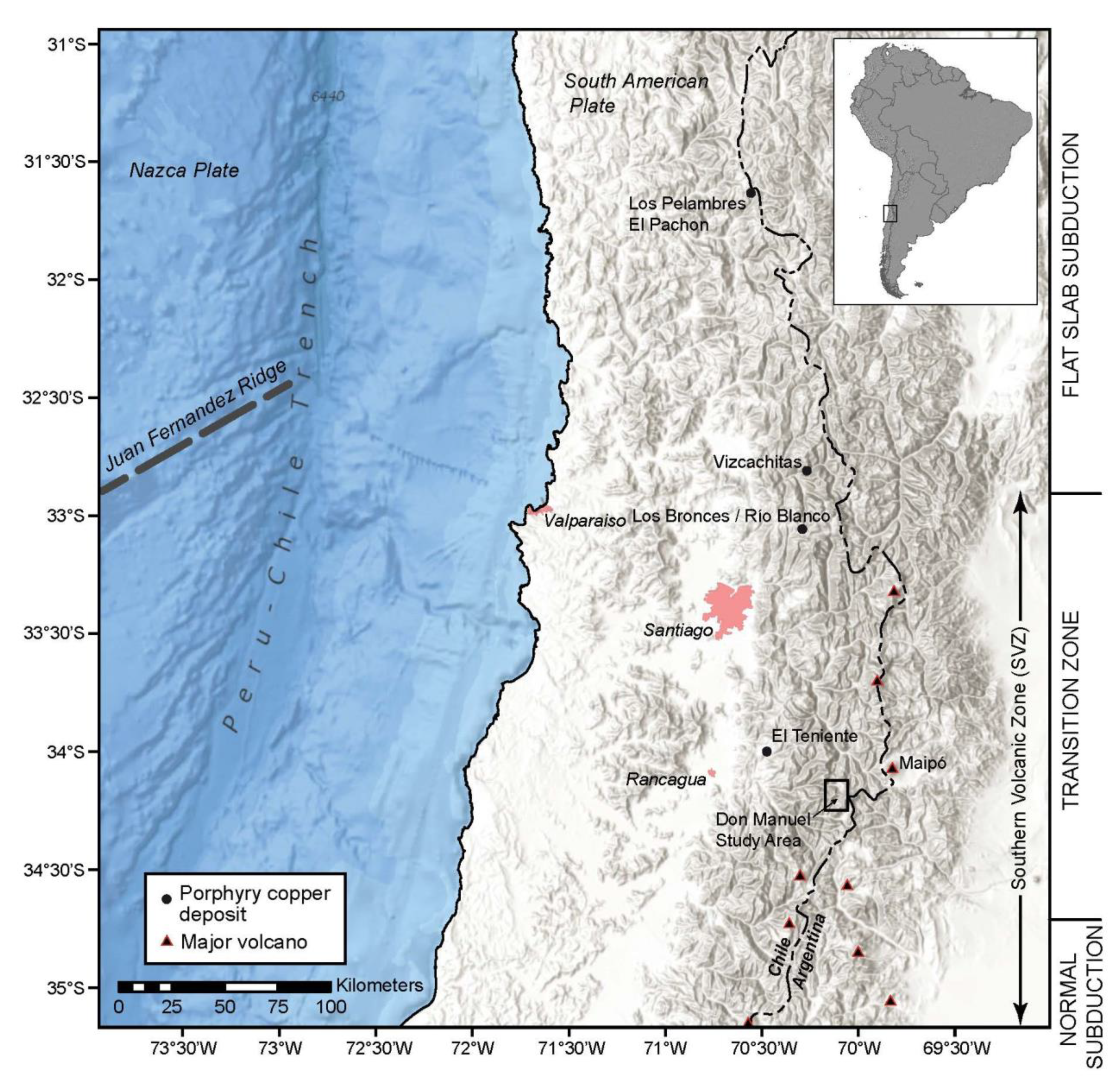


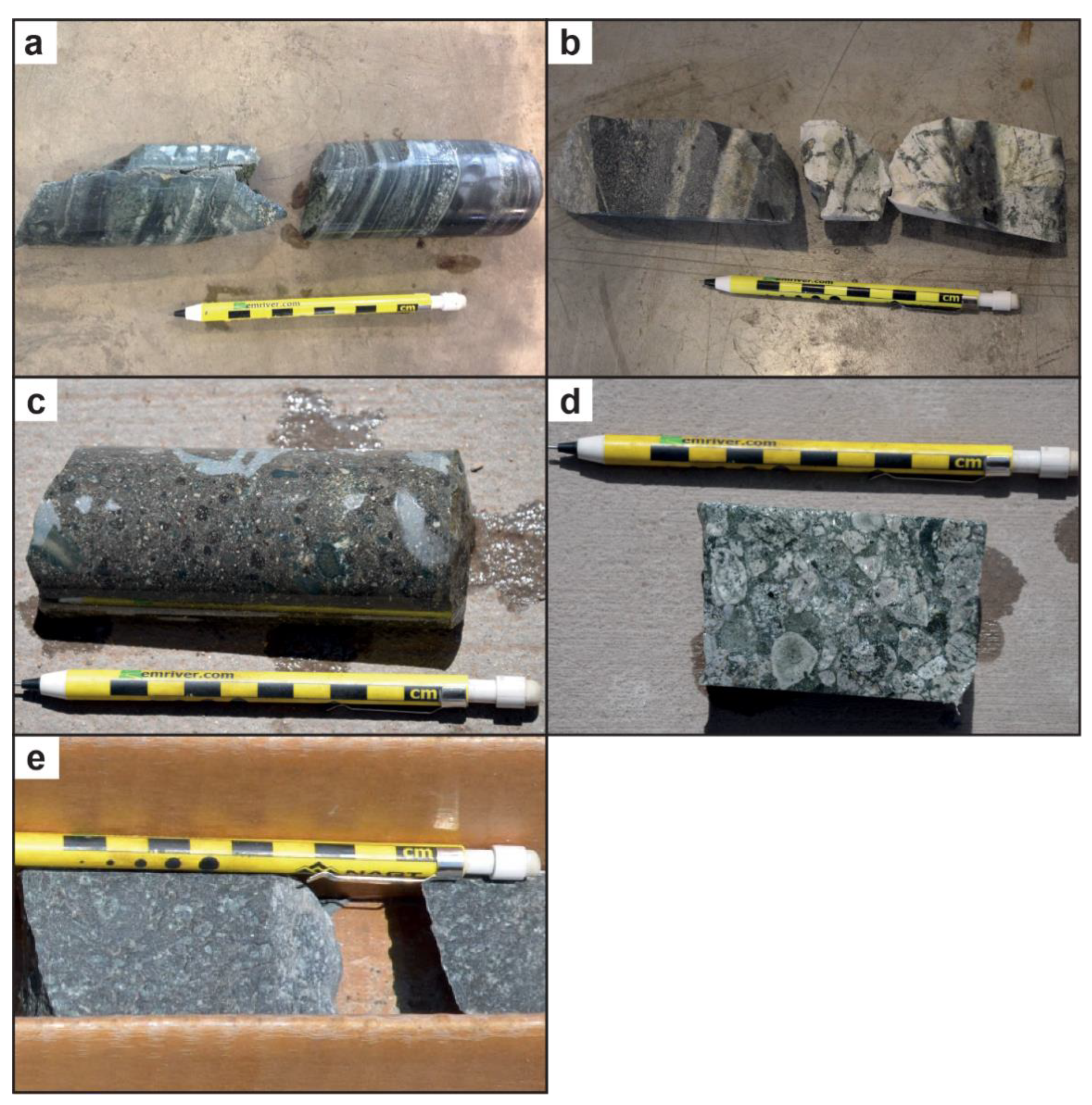


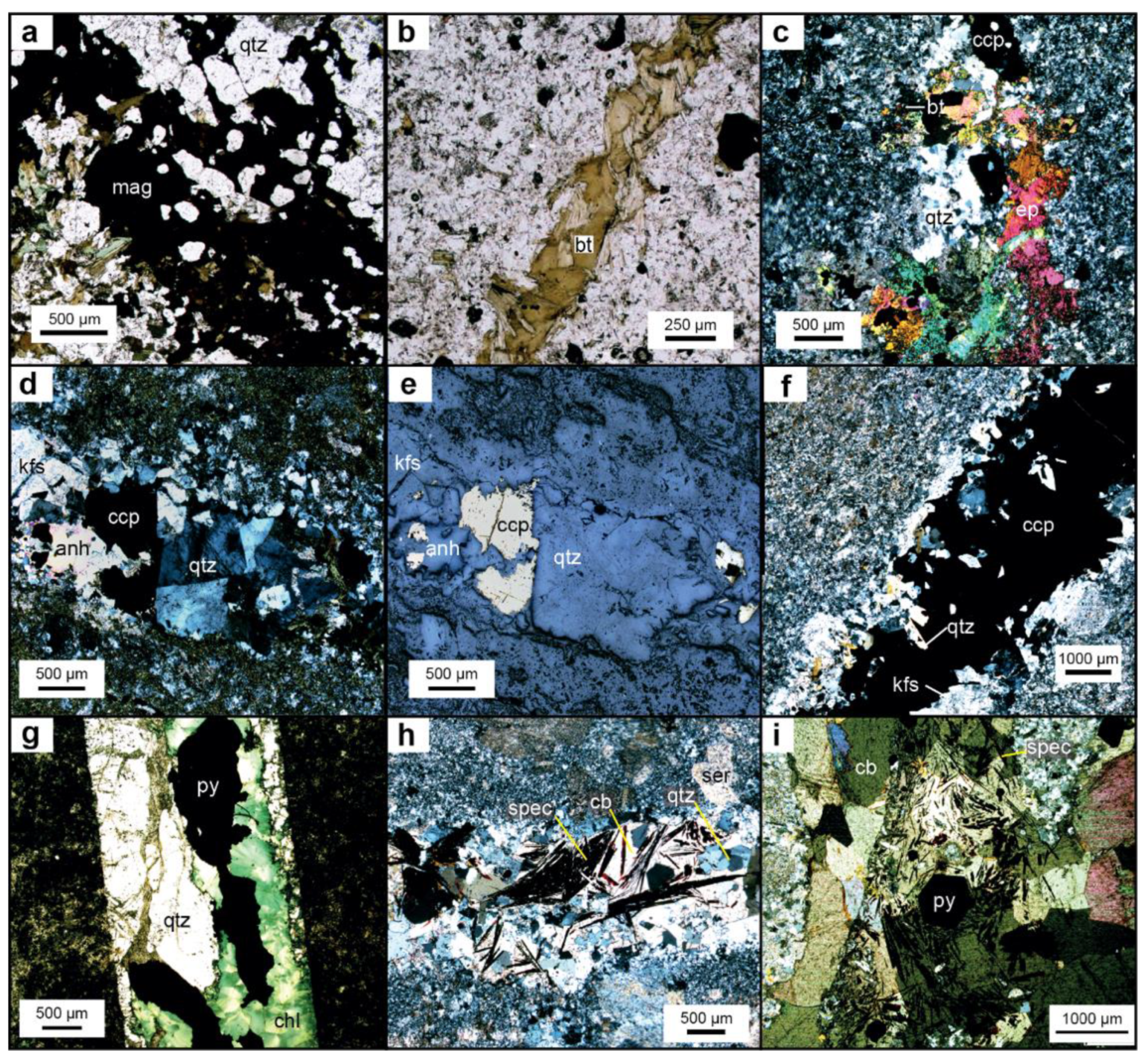
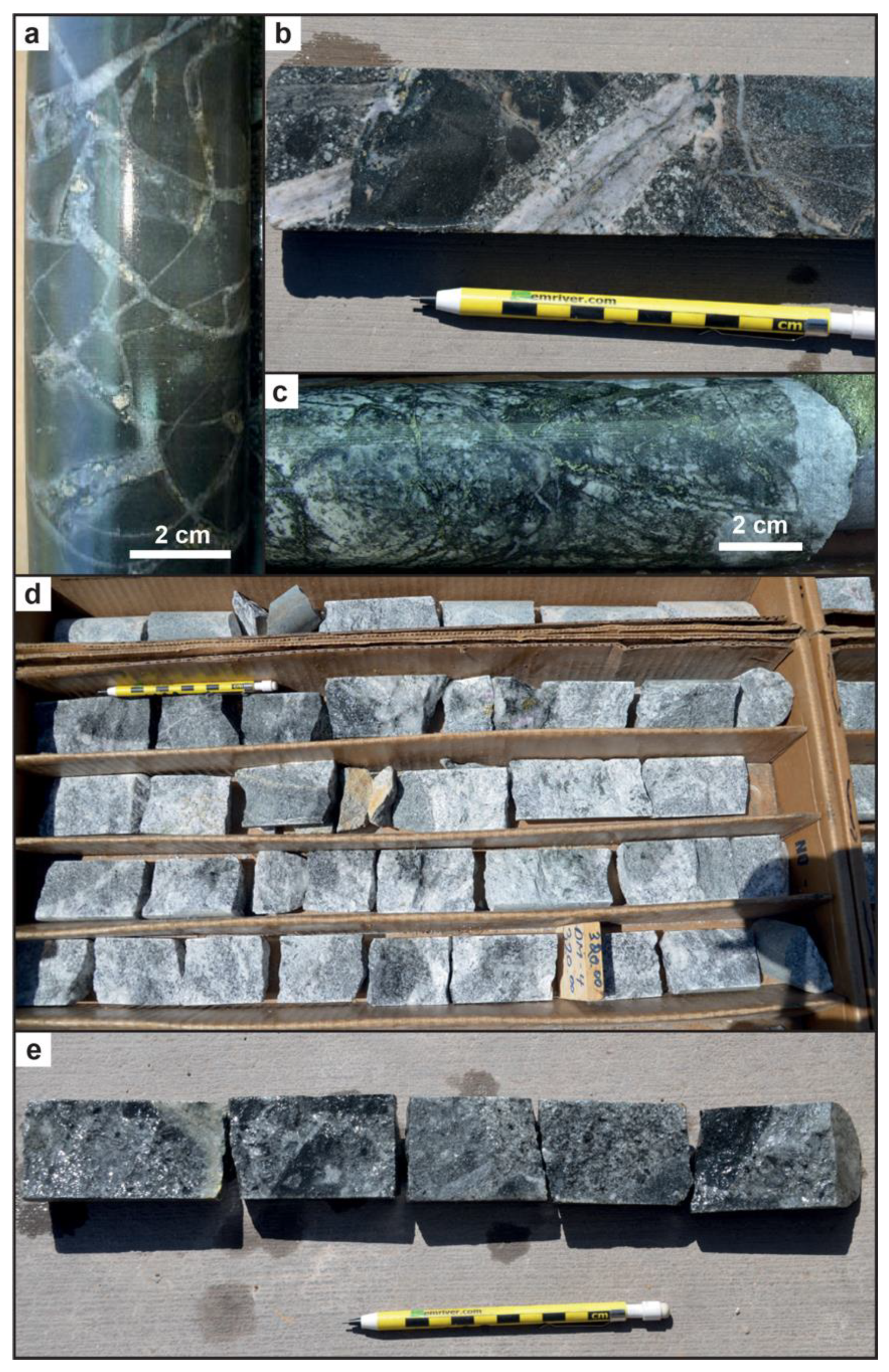
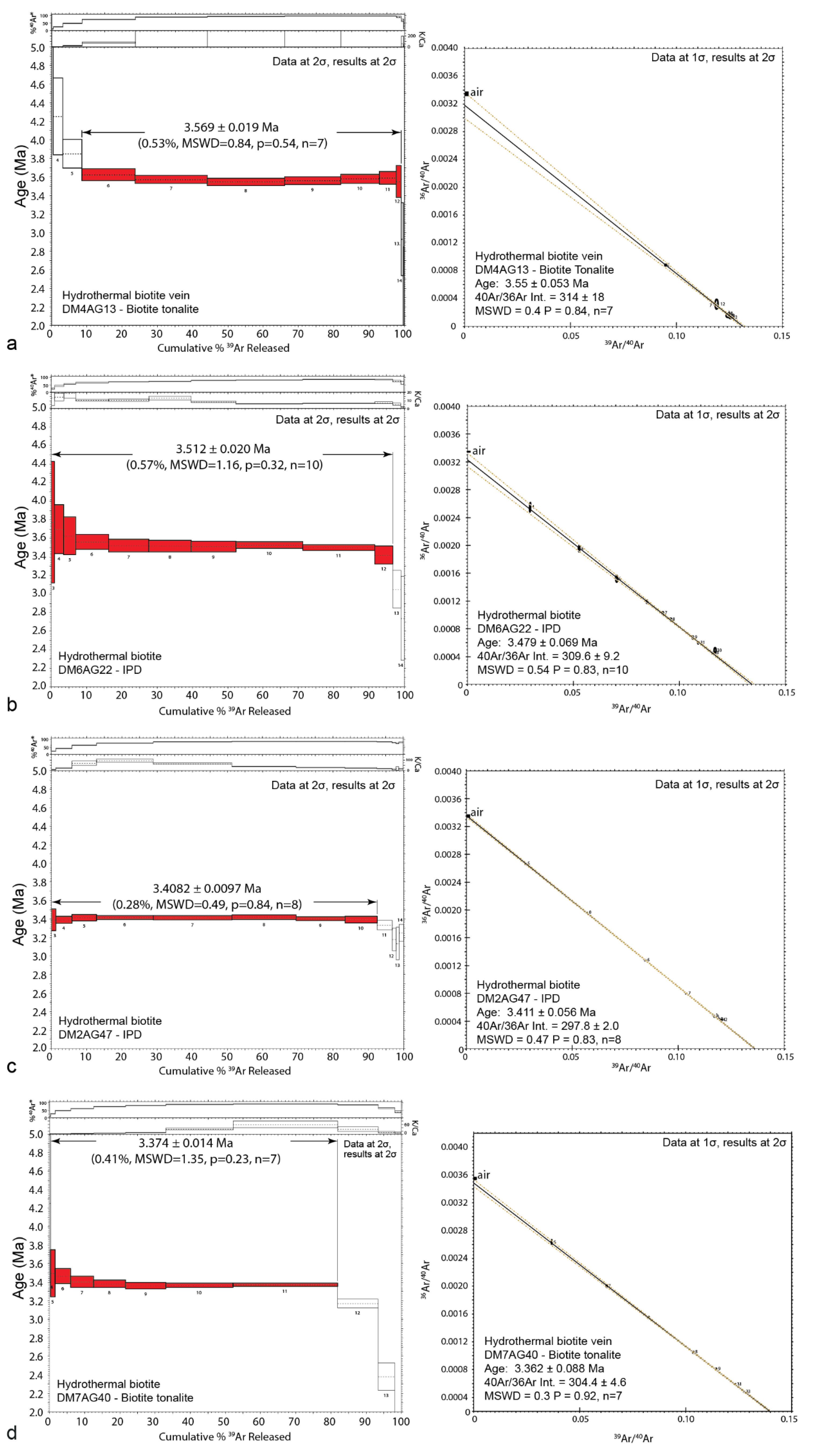

| Rock Type | Location | Age |
|---|---|---|
| Quartz monzonite | Don Manuel Principal drill core; dikes | 4.058 ± 0.015 Ma 1,3 3.975 ± 0.058 Ma 1,3 |
| Rhyolite | Paredones; stock; outcrop | 3.879 ± 0.018 Ma 1,3 |
| Biotite tonalite | Don Manuel Principal drill core; stock | 3.829 ± 0.010 Ma 1,3 |
| Biotite tonalite (porphyritic phase) | Don Manuel Principal drill core; dikes | 3.733 ± 0.010 Ma 1,3 |
| Intermediate porphyry dike (IPD) suite | Don Manuel Principal drill core; dikes | |
| Type 1 | 3.733 ± 0.048 Ma 1,3 | |
| Type 2 | 3.657 ± 0.031 Ma 1,3 3.656 ± 0.029 Ma 1,3 | |
| Type 3 | 3.912 ± 0.057 Ma 1,3 | |
| Mafic enclaves | Don Manuel Principal drill core; hosted by rhyodacite, biotite tonalite, and IPD | |
| Cpx basaltic andesite dikes | Paredones; dikes; outcrop | |
| Basaltic andesite dikes | Don Manuel Principal drill core; occurs as dikes | 3.85 ± 0.19 Ma 2,3; 3.36 ± 0.09 Ma 2,3; 3.24 ± 0.06 Ma 2,3; 2.96 ± 0.11 Ma 2,3; 2.88 ± 0.06 Ma 2,3 |
| Vein Stage | Vein Type | Subtype | Mineralogy | Vein Halo | Associated Alteration Stage |
|---|---|---|---|---|---|
| Early stage | 1 | Magnetite ± quartz | Biotite | Potassic/sodic-Calcic (localized) | |
| 2 | Biotite ± actinolite ± chlorite | Biotite | Potassic/sodic-Calcic (localized) | ||
| 3 | Quartz ± K-feldspar, biotite, epidote, anhydrite, chalcopyrite, magnetite | Biotite ± chlorite/no halo | Potassic | ||
| Primary mineralization stage | 4 | a | Quartz ± K-feldspar, anhydrite, chalcopyrite, pyrite, bornite, specularite, molybdenite | No halo/K-Feldspar halo | Potassic |
| b | Chalcopyrite ± quartz, pyrite | No halo/K-Feldspar halo | Potassic | ||
| 5 | Chlorite + quartz ± actinolite, K-feldspar, pyrite, chalcopyrite | Quartz halo/no halo | Potassic/propyllitic | ||
| 6 | Quartz + anhydrite ± chalcopyrite, pyrite, molybdenite, bornite, specularite, fluorite | No halo | Chlorite-sericite | ||
| Late mineralization stage | 7 | Quartz ± chalcopyrite, pyrite, specularite, molybdenite, calcite | Sericite ± chlorite halo | Chlorite-sericite | |
| 8 | Quartz + anhydrite ± carbonate, chalcopyrite, pyrite, specularite, molybdenite | Sericite ± chlorite halo | Chlorite-sericite | ||
| 9 | Carbonate ± barite, gypsum, specularite, pyrite, molybdenite | Sericite halo or no halo | Argillic |
| Sample | Drill Hole, Depth (m), Elevation (m, a.s.l.) | Description | Mineral, Dating Technique |
|---|---|---|---|
| DM4AG13 | DM4, 283, 2762 | Porphyritic biotite tonalite with weak potassic alteration; Type 3 vein with quartz, biotite, potassium feldspar, and chalcopyrite | Biotite, 40Ar/39Ar |
| DM6AG22 | DM6, 535, 2510 | Intermediate porphyry dike (unclassified) with moderate potassic alteration; aggregate of secondary biotite associated with disseminated pyrite and chalcopyrite | Biotite, 40Ar/39Ar |
| DM2AG47 | DM2, 358, 2722 | Intermediate porphryry dike (unclassified) with intense potassic alteration; disseminated hydrothermal biotite | Biotite, 40Ar/39Ar |
| DM7AG40 | DM7, 1049, 2263 | Equigranular biotite tonalite with weak potassic alteration; Type 3 vein with quartz, biotite, fluorite, and chalcopyrite | Biotite, 40Ar/39Ar |
| DM5AG34 | DM5, 503, 2737 | Don Manuel Principal basaltic andesite dike crosscutting volcanic hornfels of the Coya Machali Formation | Whole rock, 40Ar/39Ar |
| DM5AG07 | DM5, 146, 3094 | Don Manuel Principal basaltic andesite dike crosscutting an intermediated porphyry dike | Whole rock, 40Ar/39Ar |
| DM8AG40 | DM8, 546, 2620 | Don Manuel Principal basaltic andesite dike crosscutting sedimentary hornfels of the Coya Machali Formation | Whole rock, 40Ar/39Ar |
| DM7AG06 | DM7, 127, 3185 | Don Manuel Principal basaltic andesite dike crosscutting sedimentary hornfels of the Coya Machali Formation | Whole rock, 40Ar/39Ar |
| DM4AG35 | DM4, 564, 2481 | Intermediate porphyry dike (IPD2) with weak potassic alteration; Type 6 vein quartz-anhydrite-molybdenite | Molybdenite, Re-Os |
| DM7AG31 | DM7, 836, 2476 | Silicified sedimentary hornfels of the Coya Machali Formation; Type 8 with quartz + molybdenite, chalcopyrite, anhydrite with a sericite halo | Molybdenite, Re-Os |
| DM7AG32 | DM7, 839, 2473 | Silicified sedimentary hornfels of the Coya Machali Formation; Type 8 with quartz + molybdenite, chalcopyrite, anhydrite with a sericite halo | Molybdenite, Re-Os |
| Sample | wt (g) | Re (ppm) | 2σ | 187Re (ppm) | 2σ | 187Os (ppb) | 2σ | Date (Ma) | 2σ |
|---|---|---|---|---|---|---|---|---|---|
| DM4AG35 | 0.049 | 95.72 | 0.27 | 60.16 | 0.17 | 0.82 | 0.002 | 0.814 | 0.009 |
| DM7AG31 | 0.050 | 204.73 | 0.37 | 128.68 | 0.23 | 7.32 | 0.02 | 3.416 | 0.037 |
| DM7AG32 | 0.047 | 127.76 | 0.13 | 80.31 | 0.08 | 4.58 | 0.02 | 3.425 | 0.037 |
Publisher’s Note: MDPI stays neutral with regard to jurisdictional claims in published maps and institutional affiliations. |
© 2021 by the authors. Licensee MDPI, Basel, Switzerland. This article is an open access article distributed under the terms and conditions of the Creative Commons Attribution (CC BY) license (http://creativecommons.org/licenses/by/4.0/).
Share and Cite
Gilmer, A.K.; Sparks, R.S.J.; Barfod, D.N.; Brugge, E.R.; Parkinson, I.J. Duration of Hydrothermal Alteration and Mineralization of the Don Manuel Porphyry Copper System, Central Chile. Minerals 2021, 11, 174. https://doi.org/10.3390/min11020174
Gilmer AK, Sparks RSJ, Barfod DN, Brugge ER, Parkinson IJ. Duration of Hydrothermal Alteration and Mineralization of the Don Manuel Porphyry Copper System, Central Chile. Minerals. 2021; 11(2):174. https://doi.org/10.3390/min11020174
Chicago/Turabian StyleGilmer, Amy K., R. Stephen J. Sparks, Dan N. Barfod, Emily R. Brugge, and Ian J. Parkinson. 2021. "Duration of Hydrothermal Alteration and Mineralization of the Don Manuel Porphyry Copper System, Central Chile" Minerals 11, no. 2: 174. https://doi.org/10.3390/min11020174
APA StyleGilmer, A. K., Sparks, R. S. J., Barfod, D. N., Brugge, E. R., & Parkinson, I. J. (2021). Duration of Hydrothermal Alteration and Mineralization of the Don Manuel Porphyry Copper System, Central Chile. Minerals, 11(2), 174. https://doi.org/10.3390/min11020174





